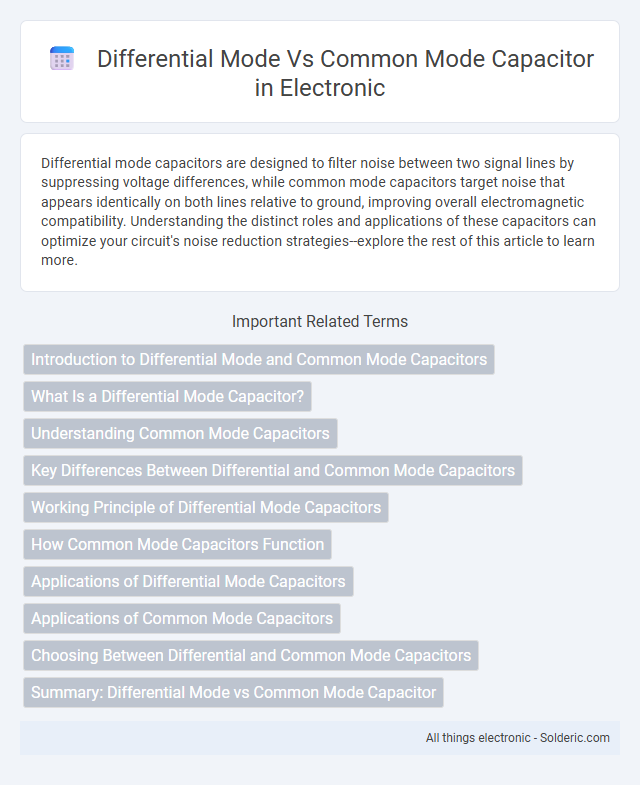Differential mode capacitors are designed to filter noise between two signal lines by suppressing voltage differences, while common mode capacitors target noise that appears identically on both lines relative to ground, improving overall electromagnetic compatibility. Understanding the distinct roles and applications of these capacitors can optimize your circuit's noise reduction strategies--explore the rest of this article to learn more.
Comparison Table
| Feature | Differential Mode Capacitor | Common Mode Capacitor |
|---|---|---|
| Function | Filters differential mode noise between two lines | Suppresses common mode noise between line and ground |
| Connection | Connected across two signal lines | Connected from each line to ground or reference |
| Noise Type | Targets differential noise signals | Targets common mode noise signals |
| Typical Usage | Power supply filtering, signal integrity | EMI/RFI suppression, grounding noise reduction |
| Impedance | Low impedance for differential frequency range | Low impedance for common mode frequency range |
| Capacitance Value | Usually lower, matched to signal lines | Usually higher, designed for wideband noise suppression |
Introduction to Differential Mode and Common Mode Capacitors
Differential mode capacitors suppress noise signals that appear between two conductors carrying opposite currents, effectively filtering high-frequency interference in signal lines. Common mode capacitors target noise signals present between both conductors and the ground, reducing electromagnetic interference that affects multiple circuits simultaneously. Knowing the difference between these capacitors helps you choose the right component for enhancing electromagnetic compatibility (EMC) in your electronic designs.
What Is a Differential Mode Capacitor?
A differential mode capacitor is designed to filter noise signals that appear between two conductors carrying opposite but equal currents, commonly found in power lines or communication cables. This capacitor targets differential mode noise by providing a low impedance path for high-frequency interference, improving signal integrity and reducing electromagnetic interference (EMI). Understanding the role of differential mode capacitors is essential for optimizing your circuit's performance and minimizing disruptions caused by differential noise.
Understanding Common Mode Capacitors
Common mode capacitors are designed to filter unwanted noise signals that appear identically on two or more conductors relative to a common reference ground, effectively reducing electromagnetic interference (EMI) in electronic circuits. These capacitors provide a low impedance path for common mode noise, enhancing signal integrity and protecting sensitive components from high-frequency disturbances. Their application is essential in power supplies, signal lines, and communication interfaces where common mode noise can degrade performance or cause malfunctions.
Key Differences Between Differential and Common Mode Capacitors
Differential mode capacitors are designed to filter noise between two signal lines by allowing current to pass in opposite directions, effectively reducing differential noise in electronic circuits. Common mode capacitors target noise signals that appear simultaneously and in phase on two lines, shunting them to ground to minimize electromagnetic interference (EMI). Key differences include their placement in circuits, with differential mode capacitors placed across conductors and common mode capacitors connected from line to ground, and their distinct roles in noise suppression for enhanced signal integrity.
Working Principle of Differential Mode Capacitors
Differential mode capacitors function by filtering noise signals that flow between two conductors carrying differential currents with opposite polarity. These capacitors store and release electrical energy to counteract voltage spikes caused by high-frequency noise, effectively smoothing out differential mode interference. Their design ensures minimal impact on the normal signal while providing targeted attenuation of unwanted noise in electronic circuits.
How Common Mode Capacitors Function
Common mode capacitors function by filtering noise signals that appear simultaneously and in phase on both conductors of a pair, effectively shunting unwanted high-frequency interference to ground. These capacitors are typically connected between the two lines and the ground, providing a low impedance path for common mode noise without affecting differential signals. Their role is crucial in improving electromagnetic compatibility (EMC) by suppressing electromagnetic interference (EMI) in electronic circuits.
Applications of Differential Mode Capacitors
Differential mode capacitors are primarily used in applications requiring noise reduction between two conductors carrying opposite signals, such as in power supply lines and signal transmission systems. Your devices benefit from these capacitors by improving signal integrity and reducing electromagnetic interference (EMI) in data communication, audio equipment, and switching power supplies. These capacitors enhance performance by filtering differential noise while maintaining circuit stability.
Applications of Common Mode Capacitors
Common mode capacitors are primarily used in power supply circuits, electromagnetic interference (EMI) filters, and noise suppression applications to reduce high-frequency noise common to both lines. These capacitors improve signal integrity by filtering out unwanted common mode currents in AC/DC power lines, motor drives, and communication systems. Their effectiveness in protecting sensitive electronic devices from interference makes them essential components in industrial, automotive, and consumer electronics.
Choosing Between Differential and Common Mode Capacitors
Choosing between differential and common mode capacitors depends on your circuit's noise filtering requirements and signal integrity. Differential mode capacitors filter noise appearing between two conductors by shunting differential noise signals, making them ideal for high-speed data lines. Common mode capacitors suppress noise signals common to both conductors relative to ground, effectively reducing electromagnetic interference and improving overall system stability.
Summary: Differential Mode vs Common Mode Capacitor
Differential mode capacitors are designed to filter noise signals that appear between two conductors, targeting differential signal interference. Common mode capacitors suppress noise signals common to both conductors relative to the ground, effectively reducing electromagnetic interference (EMI). Choosing the right capacitor type ensures Your circuit achieves optimal noise reduction and improved signal integrity.
Differential mode vs common mode capacitor Infographic

 solderic.com
solderic.com